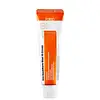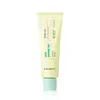What's inside
What's inside
 Key Ingredients
Key Ingredients

 Benefits
Benefits

 Concerns
Concerns

 Ingredients Side-by-side
Ingredients Side-by-side

Hippophae Rhamnoides Fruit Extract 70%
Skin ConditioningGlycerin
HumectantMethylpropanediol
SolventCetyl Ethylhexanoate
EmollientSimmondsia Chinensis Seed Oil
Emollient1,2-Hexanediol
Skin ConditioningNiacinamide
SmoothingPolyglyceryl-3 Methylglucose Distearate
EmulsifyingCetearyl Alcohol
EmollientPhenyl Trimethicone
Skin ConditioningPanthenol
Skin ConditioningSodium Hyaluronate
HumectantPortulaca Oleracea Extract
Skin ConditioningCitrus Unshiu Extract
Skin ConditioningButylene Glycol
HumectantAdenosine
Skin ConditioningSorbitan Stearate
EmulsifyingGlyceryl Stearate Se
EmulsifyingMethyl Methacrylate Crosspolymer
Carbomer
Emulsion StabilisingArginine
MaskingAmmonium Acryloyldimethyltaurate/Vp Copolymer
Water
Skin ConditioningCaprylyl Glycol
EmollientEthylhexylglycerin
Skin ConditioningDisodium EDTA
Hippophae Rhamnoides Fruit Extract 70%, Glycerin, Methylpropanediol, Cetyl Ethylhexanoate, Simmondsia Chinensis Seed Oil, 1,2-Hexanediol, Niacinamide, Polyglyceryl-3 Methylglucose Distearate, Cetearyl Alcohol, Phenyl Trimethicone, Panthenol, Sodium Hyaluronate, Portulaca Oleracea Extract, Citrus Unshiu Extract, Butylene Glycol, Adenosine, Sorbitan Stearate, Glyceryl Stearate Se, Methyl Methacrylate Crosspolymer, Carbomer, Arginine, Ammonium Acryloyldimethyltaurate/Vp Copolymer, Water, Caprylyl Glycol, Ethylhexylglycerin, Disodium EDTA
Water
Skin ConditioningGlycerin
HumectantDipropylene Glycol
HumectantPropanediol
Solvent1,2-Hexanediol
Skin ConditioningNiacinamide
SmoothingNeopentyl Glycol Diheptanoate
EmollientMethyl Trimethicone
Skin ConditioningCetyl Alcohol
EmollientStearyl Alcohol
EmollientCoco-Caprylate/Caprate
EmollientDiisostearyl Malate
EmollientPhenyl Trimethicone
Skin ConditioningPalmitic Acid
EmollientHydroxyethyl Acrylate/Sodium Acryloyldimethyl Taurate Copolymer
Emulsion StabilisingStearic Acid
CleansingGlycereth-25 PCA Isostearate
EmulsifyingGlyceryl Stearate
EmollientAcrylates/C10-30 Alkyl Acrylate Crosspolymer
Emulsion StabilisingTromethamine
BufferingButylene Glycol
HumectantCoptis Japonica Extract
AntimicrobialXanthan Gum
EmulsifyingCeramide NP
Skin ConditioningEthylhexylglycerin
Skin ConditioningAdenosine
Skin ConditioningCitrus Aurantium Bergamia Fruit Oil
MaskingLavandula Angustifolia Oil
MaskingCentella Asiatica Extract
CleansingBifida Ferment Lysate
Skin ConditioningCitrus Aurantium Dulcis Peel Oil
MaskingAniba Rosaeodora Wood Oil
AstringentRosmarinus Officinalis Leaf Oil
MaskingEucalyptus Globulus Leaf Oil
PerfumingSodium Hyaluronate
HumectantCaprylic/Capric Triglyceride
MaskingAdansonia Digitata Seed Oil
EmollientHydrogenated Lecithin
EmulsifyingHyaluronic Acid
HumectantTocopheryl Acetate
AntioxidantTocopherol
AntioxidantSqualane
EmollientArtemisia Vulgaris Extract
Skin ConditioningAllantoin
Skin ConditioningCocos Nucifera Oil
MaskingPanthenol
Skin ConditioningHydrolyzed Collagen
EmollientCeramide Ns
Skin ConditioningCeramide As
Skin ConditioningMannitol
HumectantBentonite
AbsorbentCeramide EOP
Skin ConditioningCeramide AP
Skin ConditioningXylitylglucoside
HumectantAnhydroxylitol
HumectantHydrolyzed Hyaluronic Acid
HumectantXylitol
HumectantOlive Oil Decyl Esters
Camellia Sinensis Leaf Extract
AntimicrobialAnthemis Nobilis Flower Oil
MaskingCitrus Aurantifolia Fruit Extract
Skin ConditioningAdansonia Digitata Leaf Extract
Skin ConditioningCitric Acid
BufferingHydrated Silica
AbrasiveGlucose
HumectantPelargonium Graveolens Flower Oil
MaskingPseudoalteromonas Ferment Extract
HumectantMentha Viridis Leaf Oil
AstringentCaprylyl Glycol
EmollientLactic Acid
BufferingRose Flower Oil
MaskingCalendula Officinalis Extract
Skin ConditioningChamomilla Recutita Extract
Skin ConditioningPropolis Extract
Skin ConditioningSqualene
EmollientPalmitoyl Tripeptide-5
Skin ConditioningChlorella Minutissima Extract
Skin ConditioningAcetyl Tetrapeptide-11
Skin ConditioningPhellinus Linteus Extract
Skin ConditioningDipeptide Diaminobutyroyl Benzylamide Diacetate
Skin ConditioningMelissa Officinalis Leaf Extract
Skin ConditioningSerine
MaskingAlanine
MaskingProline
Skin ConditioningSodium Phosphate
BufferingSea Salt
AbrasiveAcetyl Hexapeptide-8
HumectantBeta-Glucan
Skin ConditioningSodium Hydroxide
BufferingMelaleuca Alternifolia Leaf Extract
PerfumingOligopeptide-1
Skin ConditioningDisodium EDTA
Water, Glycerin, Dipropylene Glycol, Propanediol, 1,2-Hexanediol, Niacinamide, Neopentyl Glycol Diheptanoate, Methyl Trimethicone, Cetyl Alcohol, Stearyl Alcohol, Coco-Caprylate/Caprate, Diisostearyl Malate, Phenyl Trimethicone, Palmitic Acid, Hydroxyethyl Acrylate/Sodium Acryloyldimethyl Taurate Copolymer, Stearic Acid, Glycereth-25 PCA Isostearate, Glyceryl Stearate, Acrylates/C10-30 Alkyl Acrylate Crosspolymer, Tromethamine, Butylene Glycol, Coptis Japonica Extract, Xanthan Gum, Ceramide NP, Ethylhexylglycerin, Adenosine, Citrus Aurantium Bergamia Fruit Oil, Lavandula Angustifolia Oil, Centella Asiatica Extract, Bifida Ferment Lysate, Citrus Aurantium Dulcis Peel Oil, Aniba Rosaeodora Wood Oil, Rosmarinus Officinalis Leaf Oil, Eucalyptus Globulus Leaf Oil, Sodium Hyaluronate, Caprylic/Capric Triglyceride, Adansonia Digitata Seed Oil, Hydrogenated Lecithin, Hyaluronic Acid, Tocopheryl Acetate, Tocopherol, Squalane, Artemisia Vulgaris Extract, Allantoin, Cocos Nucifera Oil, Panthenol, Hydrolyzed Collagen, Ceramide Ns, Ceramide As, Mannitol, Bentonite, Ceramide EOP, Ceramide AP, Xylitylglucoside, Anhydroxylitol, Hydrolyzed Hyaluronic Acid, Xylitol, Olive Oil Decyl Esters, Camellia Sinensis Leaf Extract, Anthemis Nobilis Flower Oil, Citrus Aurantifolia Fruit Extract, Adansonia Digitata Leaf Extract, Citric Acid, Hydrated Silica, Glucose, Pelargonium Graveolens Flower Oil, Pseudoalteromonas Ferment Extract, Mentha Viridis Leaf Oil, Caprylyl Glycol, Lactic Acid, Rose Flower Oil, Calendula Officinalis Extract, Chamomilla Recutita Extract, Propolis Extract, Squalene, Palmitoyl Tripeptide-5, Chlorella Minutissima Extract, Acetyl Tetrapeptide-11, Phellinus Linteus Extract, Dipeptide Diaminobutyroyl Benzylamide Diacetate, Melissa Officinalis Leaf Extract, Serine, Alanine, Proline, Sodium Phosphate, Sea Salt, Acetyl Hexapeptide-8, Beta-Glucan, Sodium Hydroxide, Melaleuca Alternifolia Leaf Extract, Oligopeptide-1, Disodium EDTA
Ingredients Explained
These ingredients are found in both products.
Ingredients higher up in an ingredient list are typically present in a larger amount.
1,2-Hexanediol is a synthetic liquid and another multi-functional powerhouse.
It is a:
- Humectant, drawing moisture into the skin
- Emollient, helping to soften skin
- Solvent, dispersing and stabilizing formulas
- Preservative booster, enhancing the antimicrobial activity of other preservatives
Adenosine is in every living organism. It is one of four components in nucleic acids that helps store our DNA.
Adenosine has many benefits when used. These benefits include hydrating the skin, smoothing skin, and reducing wrinkles. Once applied, adenosine increases collagen production. It also helps with improving firmness and tissue repair.
Studies have found adenosine may also help with wound healing.
In skincare products, Adenosine is usually derived from yeast.
Learn more about AdenosineButylene Glycol (or BG) is used within cosmetic products for a few different reasons:
Overall, Butylene Glycol is a safe and well-rounded ingredient that works well with other ingredients.
Though this ingredient works well with most skin types, some people with sensitive skin may experience a reaction such as allergic rashes, closed comedones, or itchiness.
Learn more about Butylene GlycolCaprylyl Glycol is a humectant and emollient, meaning it attracts and preserves moisture.
It is a common ingredient in many products, especially those designed to hydrate skin. The primary benefits are retaining moisture, skin softening, and promoting a healthy skin barrier.
Though Caprylyl Glycol is an alcohol derived from fatty acids, it is not the kind that can dry out skin.
This ingredient is also used as a preservative to extend the life of products. It has slight antimicrobial properties.
Learn more about Caprylyl GlycolDisodium EDTA plays a role in making products more stable by aiding other preservatives.
It is a chelating agent, meaning it neutralizes metal ions that may be found in a product.
Disodium EDTA is a salt of edetic acid and is found to be safe in cosmetic ingredients.
Learn more about Disodium EDTAEthylhexylglycerin (we can't pronounce this either) is commonly used as a preservative and skin softener. It is derived from glyceryl.
You might see Ethylhexylglycerin often paired with other preservatives such as phenoxyethanol. Ethylhexylglycerin has been found to increase the effectiveness of these other preservatives.
Glycerin is already naturally found in your skin. It helps moisturize and protect your skin.
A study from 2016 found glycerin to be more effective as a humectant than AHAs and hyaluronic acid.
As a humectant, it helps the skin stay hydrated by pulling moisture to your skin. The low molecular weight of glycerin allows it to pull moisture into the deeper layers of your skin.
Hydrated skin improves your skin barrier; Your skin barrier helps protect against irritants and bacteria.
Glycerin has also been found to have antimicrobial and antiviral properties. Due to these properties, glycerin is often used in wound and burn treatments.
In cosmetics, glycerin is usually derived from plants such as soybean or palm. However, it can also be sourced from animals, such as tallow or animal fat.
This ingredient is organic, colorless, odorless, and non-toxic.
Glycerin is the name for this ingredient in American English. British English uses Glycerol/Glycerine.
Learn more about GlycerinNiacinamide is a multitasking form of vitamin B3 that strengthens the skin barrier, reduces pores and dark spots, regulates oil, and improves signs of aging.
And the best part? It's gentle and well-tolerated by most skin types, including sensitive and reactive skin.
You might have heard of "niacin flush", or the reddening of skin that causes itchiness. Niacinamide has not been found to cause this.
In very rare cases, some individuals may not be able to tolerate niacinamide at all or experience an allergic reaction to it.
If you are experiencing flaking, irritation, and dryness with this ingredient, be sure to double check all your products as this ingredient can be found in all categories of skincare.
When incorporating niacinamide into your routine, look out for concentration amounts. Typically, 5% niacinamide provides benefits such as fading dark spots. However, if you have sensitive skin, it is better to begin with a smaller concentration.
When you apply niacinamide to your skin, your body converts it into nicotinamide adenine dinucleotide (NAD). NAD is an essential coenzyme that is already found in your cells as "fuel" and powers countless biological processes.
In your skin, NAD helps repair cell damage, produce new healthy cells, support collagen production, strengthen the skin barrier, and fight environmental stressors (like UV and pollution).
Our natural NAD levels start to decline with age, leading to slower skin repair, visible aging, and a weaker skin barrier. By providing your skin niacinamide, you're recharging your skin's NAD levels. This leads to stronger, healthier, and younger looking skin.
Another name for vitamin B3 is nicotinamide. This vitamin is water-soluble and our bodies don't store it. We obtain Vitamin B3 from either food or skincare. Meat, fish, wheat, yeast, and leafy greens contain vitamin B3.
The type of niacinamide used in skincare is synthetically created.
Learn more about NiacinamidePanthenol is a common ingredient that helps hydrate and soothe the skin. It is found naturally in our skin and hair.
There are two forms of panthenol: D and L.
D-panthenol is also known as dexpanthenol. Most cosmetics use dexpanthenol or a mixture of D and L-panthenol.
Panthenol is famous due to its ability to go deeper into the skin's layers. Using this ingredient has numerous pros (and no cons):
Like hyaluronic acid, panthenol is a humectant. Humectants are able to bind and hold large amounts of water to keep skin hydrated.
This ingredient works well for wound healing. It works by increasing tissue in the wound and helps close open wounds.
Once oxidized, panthenol converts to pantothenic acid. Panthothenic acid is found in all living cells.
This ingredient is also referred to as pro-vitamin B5.
Learn more about PanthenolPhenyl Trimethicone is a silicon-based polymer. It is derived from silica.
Phenyl Trimethicone is used as an emollient and prevents products from foaming.
As an emollient, it helps trap moisture in the skin. It is considered an occlusive.
Learn more about Phenyl TrimethiconeSodium Hyaluronate is hyaluronic acid's salt form. It is commonly derived from the sodium salt of hyaluronic acid.
Like hyaluronic acid, it is great at holding water and acts as a humectant. This makes it a great skin hydrating ingredient.
Sodium Hyaluronate is naturally occurring in our bodies and is mostly found in eye fluid and joints.
These are some other common types of Hyaluronic Acid:
Learn more about Sodium HyaluronateWater. It's the most common cosmetic ingredient of all. You'll usually see it at the top of ingredient lists, meaning that it makes up the largest part of the product.
So why is it so popular? Water most often acts as a solvent - this means that it helps dissolve other ingredients into the formulation.
You'll also recognize water as that liquid we all need to stay alive. If you see this, drink a glass of water. Stay hydrated!
Learn more about Water